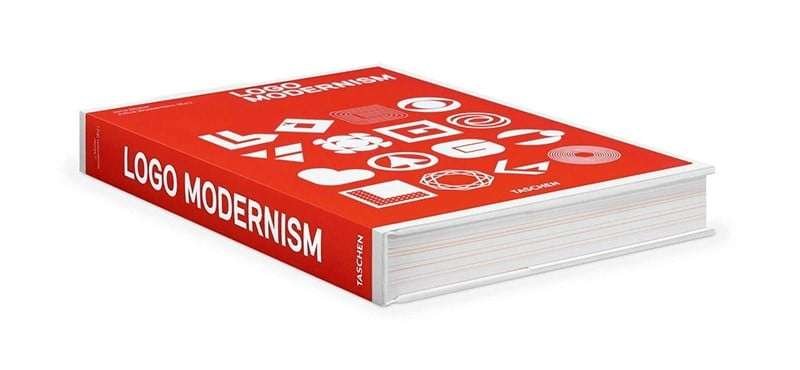In Logo Modernism, Jens Müller and R. Roger Remington offer an in-depth exploration of how modernist principles, typically found in architecture and art, have left an indelible mark on the world of logo design. Drawing on a remarkable collection of over 6,000 logos from 1940 to 1980, this book shows how the minimalist approach of modernism shaped corporate identity during this period.
Modernist design often simplifies forms to their most essential elements, a principle evident in many of the logos featured in this book. Whether it’s the clean lines or minimalist shapes, Logo Modernism shows how clarity and functionality became essential tools for creating timeless logos. Designers used geometric shapes, simple typography and minimalist effects to strip away excess detail, allowing these designs to communicate effectively with just a few elements.
Exploring Modernist Corporate Identity
The book is thoughtfully divided into three main chapters: Geometric, Effect and Typographic. Each section is further broken down into sub-categories such as dots, squares and overlays to help readers better understand the formal aspects behind these designs. This structure makes it easier to navigate the vast collection and offers valuable insights into the creative processes that shaped logo design during the Modernist era.
In addition, the book opens with an introduction by Jens Müller on the historical development of logos, accompanied by an essay by R. Roger Remington exploring the relationship between Modernism and graphic design. These texts provide valuable context and place the collection in a broader historical and cultural perspective.
Modernist aesthetics in architecture, art and product design are familiar to many. In soaring glass structures or minimalist canvases, we recognise a period of great technological advancement that affirmed man’s power to reshape his environment and radically break with the conventions or constraints of the past. Less well known, but no less fascinating, is the distillation of modernism in graphic design.

Celebrating Iconic Designers and Projects
In Logo Modernism, readers will find profiles of eight influential designers, including industry legends such as Paul Rand, Yusaku Kamekura and Anton Stankowski. These designers made significant contributions to modernist logo design, and their work continues to be studied and admired today.
Take, for example, Paul Rand’s iconic IBM logo or the striking visual identity created for the 1968 Olympic Games in Mexico. The book’s detailed case studies show how these logos became milestones in the world of branding, highlighting the universal appeal of simplicity, functionality and design excellence.
Reviews from Experts
Design experts have praised Logo Modernism for its comprehensive exploration of modernist logos. Makers Design Studio called it “the mother of all logo books”, noting its extensive collection of minimalist logos and how the clean, geometric designs continue to inspire today. In particular, they highlighted the timelessness of the logos, many of which continue to influence modern creatives.
The logo creatives emphasised the book’s value as an educational resource. They praised the structured layout, which allows each logo to stand out and gives the reader enough space to fully appreciate the designs. They called Logo Modernism a “must-have reference” for anyone studying logo design, whether for academic or practical purposes.
Other reviewers noted the book’s ability to capture the essence of modernist logo design, praising its balance of thorough research, striking visuals, and educational depth. The profiles of designers such as Paul Rand and case studies of projects such as the branding of the Olympic Games in Mexico make this a compelling read not only for designers but for anyone fascinated by the evolution of corporate identity.
A Must for Design Enthusiasts
If you’re a graphic designer, branding specialist or simply someone with an interest in business history, Logo Modernism is an invaluable resource. Not only is it visually stunning, it invites readers to reflect on the enduring power of minimalist design. Whether you’re looking for creative inspiration or want to deepen your understanding of design history, this book is an essential addition to your collection.

Where to Buy?
Want to explore the world of modernist logo design? Logo Modernism offers an in-depth look at the evolution of corporate identity since the mid-20th century. Whether you’re a designer or a history buff, you’ll find your copy here:
– Explore Logo Modernism on Amazon and discover 6,000 influential logos from 1940-1980.
– Explore Logo Modernism on Abebooks and learn how these designs helped shape visual culture.
Thank you for supporting us. If you make a purchase through these links, we may earn a small commission to help us continue to create content. Our recommendations are always unbiased and honest.
About the Author
Jens Müller, a renowned graphic designer, was born in Koblenz, Germany, in 1982 and has received numerous design awards. He is currently the creative director of the design studio Optik and a lecturer in editorial design at the Peter Behrens School of Arts. R. Roger Remington, co-author, is a professor of design with a strong focus on the history of graphic design, providing an invaluable perspective on modernist design principles.
Publishing Information
Logo Modernism by Jens Müller and R. Roger Remington is an essential guide for anyone interested in graphic design, modernist aesthetics, or corporate identity. This 432-page hardcover edition was published by Taschen on 27 March 2019. Written in English, French, and German, it offers a rich exploration of logos from the mid-20th century, making it an invaluable resource for designers, historians, and branding enthusiasts. Whether you’re a professional looking for inspiration or someone fascinated by the evolution of visual communication, this book is a must-have for your collection.





